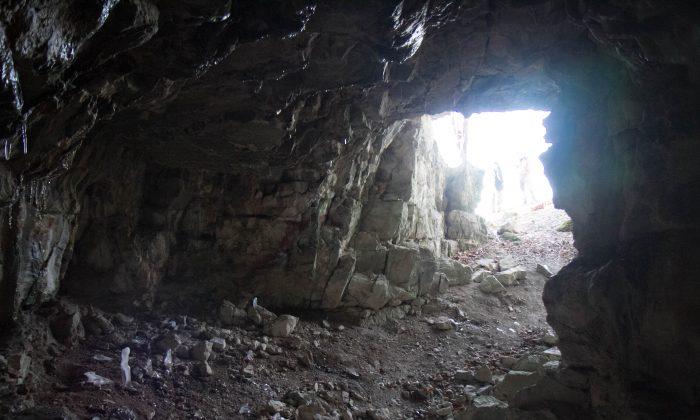GOSHEN—Just a short walk from arguably the most valuable archeological site in Orange County is a 56-acre dolomite gravel mine that the county is preparing to sell to the resident mining company, Tilcon New York, Inc.
The site, called the Dutchess Quarry Caves after Dutchess Quarry & Supply Co., Inc. that started mining there in the late 1930’s, is home to several caves that researchers believe were used by Native Americans dating back roughly 12,000 years, the end of the last ice age.
In at least one of the naturally formed caves were caribou bones and some paelo-Indian projectile points that SUNY Orange anthropology Professor Barry Kass says is some of the earliest evidence of human habitation in the region.
“This archeological site is one of the most significant sites of early human occupation in all of the Americas,” he said.
“It’s the earliest known evidence of human occupation in the lower Hudson Valley, and in the northeast.”
And it’s value has been recognized around the country and the world. The largest cave was added to the National Register of Historic places in 1974, and the site was expanded in 1995 after evidence of other caves and possibly Native American workshops and early mining activity was found nearby.
“[And] there’s probably still potentiality for further archeological investigations,” Kass said.

The caves were most likely used as temporary shelters or hunting lookouts because their west-facing direction would have made them too cold for long-term habitation, said Kass. There are rumors that there were south facing caves that were likely a more permanent residence that were destroyed when Dutchess Quarry started mining the other side of Mount Lookout, the name of the mountain the caves are carved out of.
“The people who grew up in the Florida/Goshen area as kids, some of them made claims that they played in or near this cave,” Kass said.

While the mining operation has at times been at odds with the protection of the historic site, the caves’ biggest proponent in the county legislature, legislator Jeffrey Berkman, says he is optimistic about the county’s impending sale of the property—if done under the right conditions.
Eventually the mine will need to be reclaimed, a process of restoring it to a more normal space, and Berkman says the sale is an opportunity to put some checks and balances in place in case that reclamation plan is not carried out.
He also sees the sale as an opportunity to fund some historical initiatives that could bring the public closer to Orange County’s history: roadside kiosks, money for nearby historic cemeteries, and possibly in the future an interpretive center devoted to Orange County history.
Last month, Real Property Director John McCarey proposed selling for $500,000 34.6 acres with mineral rights that the county has been leasing to Tilcon since 1970. Tilcon made this offer to the county in April.
Berkman convinced three legislative committees to table the proposal to allow more thought to be given to it and wrote up a list of questions he would like to see addressed before the county signed any contract.
Among his concerns are that the sale process be open to the public, that any sale agreement comes with penalties in case Tilcon transgresses onto protected property, and that the county retain certain lands to act as a buffer around the caves and other sensitive areas.
“Orange County must be vigilant in guarding against the scourge of this land, protect an internationally important site, while perhaps negotiating a favorable price for a portion of these lands,” Berkman wrote in a letter to his fellow legislators. “If we fail in this expectation, the costs to future taxpayers could very easily surpass the money gained from this sale.”
Dutchess Quarry
The Dutchess Quarry sale is part of larger plan to generate revenue for the county in the short term and bring in tax revenue in the long term.
“This was all done when we had budget problems a couple years ago,” McCarey said at the county’s May 24 Ways and Means committee. “We needed to sell some surplus properties and this is one of the properties we recognized as one we could sell.”
There are several reasons the county wants to have it off its hands, he said.
One is that Tilcon’s mining permit with the Department of Environmental Conservation (DEC) is up in 2018, and McCarey said he’s worried that the county could be left with the reclamation costs if Tilcon decides not to renew its permit.

Another is that Orange County is not getting as much revenue from owning the property as it used to.
In the 1960’s and into the 1970’s, McCarey said the county was making around $35,000 per year from Dutchess Quarry with a peak in 1985 of $49,000. Because Tilcon is not extracting as much from the county-owned part of the mine now, he said, and the county is getting closer to $6,000 a year.
And there’s a liability issue as well, he argues.
“Right now, if somebody’s walking up next to the caves, [they] could fall off a cliff or drown in one of those ponds,” he said.
“I think we'd be better off to get rid of it from a county point of view.”
He said they could stipulate in the sale that Tilcon cannot put another entrance or exit on Quarry Road and that a 100-foot buffer be left along the road so the mine is not visible to the public. As of the May 24 Ways and Means meeting, he said the county’s proposal would provide the caves with over 14 acres of land around them, larger than the 13.2 acres included on the National Register of Historic Places.
Based on an appraisal the county had done on the property, McCarey said he is happy with Tilcon’s offer and would like to see the deal closed within the next few months.
Reclamation
Standing on top of Mount Lookout, the view from east to west could not be more different. Plants and wildlife populate the west while to the east rocks and what looks like piles of a grey gravel give the feeling of walking onto another planet.
“It’s like a lunar landscape,” said Berkman, peering down into what looks like a craterous, grey antlion hole where the mining is being done.
In other parts of the site there are tall piles of what could be unprocessed rock or overburden that was extracted during the mining process.
It’s not supposed to stay that way forever though, thanks to a state law that requires the site be reclaimed within two years of mining being done.

The most recent reclamation plan, filed with DEC in 2005 and obtained by Epoch Times through a freedom of information request, says the mining hole will be filled in with 316 feet of ground water, and the piles of grey stone and other matter will be leveled and reseeded with plants.
“It might be a very practical idea,” Berkman said. “If you’ve got a big hole in the ground, and if it fills with water, you got a big swimming hole or a fishing hole.”
The reclamation plan, prepared for Dutchess Quarry & Supply, Co., says there are no plans to further develop the land once it is reclaimed.
In the more immediate future of the site, three committees will be looking at a local law this month that would allow the county to bypass a state law that says county property has to be sold to the highest responsible bidder. The new local law would also allow the county to declare the property surplus and make the sale of the property contingent on an easement agreement.
McCarey said he would write responses to Berkman’s concerns and give them to legislators at the Ways and Means committee on June 28.
To contact this reporter, email [email protected]





